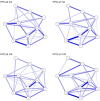Network analysis and relationship of symptom factors to functional outcomes and quality of life following mild traumatic brain injury: a TRACK-TBI study
- PMID: 38148980
- PMCID: PMC10750770
- DOI: 10.3389/fneur.2023.1308540
Network analysis and relationship of symptom factors to functional outcomes and quality of life following mild traumatic brain injury: a TRACK-TBI study
Abstract
Introduction: Mild traumatic brain injury (mTBI) is a heterogenous injury which can be difficult to characterize and manage. Using cross-sectional network analysis (NA) to conceptualize mTBI symptoms offers an innovative solution to identify how mTBI symptoms relate to each other. The centrality hypothesis of network theory posits that certain symptoms in a network are more relevant (central) or have above average influence over the rest of the network. However, no studies have used NA to characterize the interrelationships between symptoms in a cohort of patients who presented with mTBI to a U.S. Level 1 trauma center emergency department and how subacute central symptoms relate to long-term outcomes.
Methods: Patients with mTBI (Glasgow Coma Scale = 13-15) evaluated across 18 U.S. Level 1 trauma centers from 2013 to 2019 completed the Rivermead Post-Concussion Symptoms Questionnaire (RPQ) at 2 weeks (W2) post-injury (n = 1,593) and at 3 months (M3), 6 months (M6), and 12 months (M12) post-injury. Network maps were developed from RPQ subscale scores at each timepoint. RPQ scores at W2 were associated with M6 and M12 functional and quality of life outcomes.
Results: Network structure did not differ across timepoints, indicating no difference in symptoms/factors influence on the overall symptom network across time. The cognitive factor had the highest expected influence at W2 (1.761), M3 (1.245), and M6 (1.349). Fatigue had the highest expected influence at M12 (1.275). The emotional factor was the only other node with expected influence >1 at any timepoint, indicating disproportionate influence of emotional symptoms on overall symptom burden (M3 = 1.011; M6 = 1.076).
Discussion: Several symptom factors at 2-weeks post-injury were more strongly associated with incomplete recovery and/or poorer injury-related quality of life at 6 and 12 months post-injury than previously validated demographic and clinical covariates. The network analysis suggests that emotional, cognitive, and fatigue symptoms may be useful treatment targets in this population due to high centrality and activating potential of the overall symptom network.
Keywords: mild traumatic brain injuries; network analysis; quality of life; symptoms; trauma.
Copyright © 2023 Eagle, Jain, Sun, Preszler, McCrea, Giacino, Manley, Okonkwo, Nelson and The TRACK-TBI Investigators.
Conflict of interest statement
The authors declare that the research was conducted in the absence of any commercial or financial relationships that could be construed as a potential conflict of interest.
Figures


Similar articles
-
Association of Sex and Age With Mild Traumatic Brain Injury-Related Symptoms: A TRACK-TBI Study.JAMA Netw Open. 2021 Apr 1;4(4):e213046. doi: 10.1001/jamanetworkopen.2021.3046. JAMA Netw Open. 2021. PMID: 33822070 Free PMC article.
-
Invariance of the Bifactor Structure of Mild Traumatic Brain Injury (mTBI) Symptoms on the Rivermead Postconcussion Symptoms Questionnaire Across Time, Demographic Characteristics, and Clinical Groups: A TRACK-TBI Study.Assessment. 2021 Sep;28(6):1656-1670. doi: 10.1177/1073191120913941. Epub 2020 Apr 24. Assessment. 2021. PMID: 32326739 Free PMC article.
-
Symptom Frequency and Persistence in the First Year after Traumatic Brain Injury: A TRACK-TBI Study.J Neurotrauma. 2022 Mar;39(5-6):358-370. doi: 10.1089/neu.2021.0348. Epub 2022 Feb 9. J Neurotrauma. 2022. PMID: 35078327 Free PMC article.
-
[Mild traumatic brain injury and postconcussive syndrome: a re-emergent questioning].Encephale. 2012 Sep;38(4):329-35. doi: 10.1016/j.encep.2011.07.003. Epub 2011 Aug 31. Encephale. 2012. PMID: 22980474 Review. French.
-
Understanding the interplay between mild traumatic brain injury and cognitive fatigue: models and treatments.Concussion. 2017 Oct 27;2(4):CNC50. doi: 10.2217/cnc-2017-0003. eCollection 2017 Dec. Concussion. 2017. PMID: 30202591 Free PMC article. Review.
Cited by
-
Follow up rates and patient interest in clinical care after mild traumatic brain injury presenting to a level 1 trauma center: a TRACK-TBI prospective cohort study.Front Neurol. 2025 Apr 2;16:1558204. doi: 10.3389/fneur.2025.1558204. eCollection 2025. Front Neurol. 2025. PMID: 40242629 Free PMC article.
-
How Are TBI Symptoms Interconnected? A Network Analysis Approach.Brain Behav. 2025 Feb;15(2):e70316. doi: 10.1002/brb3.70316. Brain Behav. 2025. PMID: 39957078 Free PMC article.
References
-
- Brett BL, Kramer MD, Whyte J, McCrea MA, Stein MB, Giacino JT, et al. . Latent profile analysis of neuropsychiatric symptoms and cognitive function of adults 2 weeks after traumatic brain injury: findings from the TRACK-TBI study. JAMA Netw Open. (2021) 4:e213467. doi: 10.1001/jamanetworkopen.2021.3467, PMID: - DOI - PMC - PubMed

